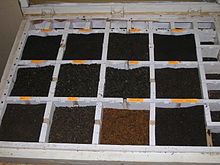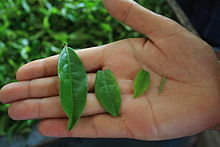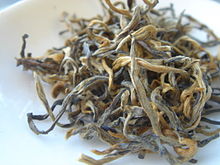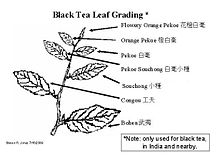- Orange pekoe
-
For the Japanese jazz band, see Orange Pekoe (band).
Orange pekoe (OP), also spelled "pecco" (usually pronounced: "peck-o") is a term used in the Western tea trade to describe a particular genre of black teas (Orange pekoe grading).[1][2] Despite a purported Chinese origin, these grading terms are typically used for teas from Sri Lanka, India and countries other than China; they are not generally known within Chinese-speaking countries. The grading system is based upon the size of processed and dried black tea leaves; high-grade teas are produced with only the best leaves.
The tea industry uses the term Orange Pekoe to describe a basic, medium-grade black tea consisting of many whole tea leaves of a specific size;[1] however, it is popular in some regions (such as North America) to use the term as a description of any generic black tea (though it is often described to the consumer as a specific variety of black tea).[3][4] Within this system, the teas that receive the highest grades are obtained from new flushes. This includes the terminal leaf bud along with a few of the youngest leaves. Grading is based on the size of the individual leaves and flushes, which is determined by their ability to fall through the screens of special meshes[5] ranging from 8–30 mesh.[6] This also determines the wholeness, or level of breakage, of each leaf, which is also part of the grading system. Although these are not the only factors used to determine quality, the size and wholeness of the leaves will have the greatest influence on the taste, clarity, and brewing-time of the tea.[7]
When used outside the context of black-tea grading, the term "pekoe" (or, occasionally, Orange pekoe) describes the unopened terminal leaf bud (tips) in tea flushes. As such, the phrases "a bud and a leaf" or "a bud and two leaves" are used to describe the "leafiness" of a flush; they are also used interchangeably with pekoe and a leaf or pekoe and two leaves.[8]
Contents
Etymology
The origin of the word "pekoe" is uncertain.
One explanation is that "pekoe" is derived from the transliterated mispronunciation of the Amoy (Xiamen) dialect word for a Chinese tea known as white down/hair (白毫; Pe̍h-ōe-jī: pe̍h-ho).[9] This is how "pekoe" is listed by Rev. Robert Morrison (1782–1834) in his Chinese dictionary (1819) as one of the seven sorts of black tea "commonly known by Europeans".[10] This refers to the down-like white "hairs" on the leaf and also to the youngest leaf buds.
Another hypothesis is that the term derives from the Chinese báihuā "white flower" (Chinese: 白花; pinyin: báihuā; Pe̍h-ōe-jī: pe̍h-hoe), and refers to the bud content of pekoe tea. Sir Thomas Lipton, the 19th-century British tea magnate is widely credited with popularizing, if not reinventing, the term for Western markets.
The "orange" in Orange Pekoe is sometimes mistaken to mean that the tea has been flavored with orange, orange oils, or is otherwise associated with oranges. However, the word "orange" is unrelated to the tea's flavor.[1] There are two explanations for the meaning of "orange" in Orange Pekoe, though neither is definitive:
- The Dutch royal House of Orange-Nassau. The Dutch East India Company performed a central role in bringing tea to Europe and may have marketed the tea as "orange" to suggest a royal warrant.[9]
- The copper color of a high-quality, oxidized leaf before drying, or the final bright orange color of the dried pekoes in the finished tea.[11] These usually consist of one leaf bud and two leaves that are covered in fine, downy hair. The orange color is produced when the tea is fully oxidized.
Manufacture and grades
Pekoe tea grades are classified into various qualities, each determined by how many of the adjacent young leaves (two, one, or none) were picked along with the leaf buds. Top-quality pekoe grades consist of only the leaf buds, which are picked using the balls of the fingertips. Fingernails and mechanical tools are not used in order to avoid bruising.
When crushed to make bagged teas, the tea is referred to as "broken", as in "Broken Orange Pekoe" (also "Broken Pekoe" or "BOP"). These lower grades include fannings and dust, which are tiny remnants created in the sorting and crushing processes.
Orange Pekoe is referred to as "OP". The grading scheme also contains categories higher than OP, which are determined primarily by leaf wholeness and size.[5][12]
Broken, Fannings and Dust orthodox teas have slightly different grades. Crush, Tear, Curl (CTC) teas, which consist of leaves mechanically rendered to uniform fannings have yet another grading system.
Grade terminology
- Choppy: Tea that contains many leaves of various sizes.
- Fannings: Small particles of tea leaves used almost exclusively in tea bags. A grade higher than Dust.
- Flowery: A large leaf, typically plucked in the second or third flush with an abundance of tips.
- Golden Flowery: Tea that includes very young tips or buds (usually golden in colour) that were picked early in the season.
- Tippy: Tea that includes an abundance of tips.
Whole leaf grades
The grades for whole leaf orthodox black tea are:
Ceylon Orange Pekoe Grades- OP1 - Orange Pekoe 1: A slightly delicate long wiry leaf with the light liquor.
- OPA - Orange Pekoe A: A bold long leaf tea which ranges from tightly wound to almost open.
- OP - Orange Pekoe: Main grade of Orange Pekoe, in the middle between OP1 and OPA.
- OP—Orange Pekoe: Main grade in tea production. Can consist of long wiry leaf without tips.
- OP sup—Orange Pekoe Superior: Primarily from Indonesia. Similar to OP.
- F OP—Flowery Orange Pekoe: High-quality tea with a long leaf and few tips. Considered the second grade in Assam, Dooars, and Bangladesh teas, but the first grade in China
- F OP1—Flowery Orange Pekoe First Grade Leaves: As above but with only the highest quality leaves in the F.O.P classification
- GF OP1—Golden Flowery Orange Pekoe First Grade Leaves: Higher proportion of tip than FOP Top grade in Milima and Marinyn regions; Uncommon in Assam and Darjeeling.
- TGF OP—Tippy Golden Flowery Orange Pekoe: Tea with the highest proportion of tip; Main grade in Darjeeling and Assam.
- TGF OP1—Tippy Golden Flowery Orange Pekoe: As above, but with only the highest quality leaves in the T.G.F.O.P classification
- FTGF OP—Finest Tippy Golden Flowery Orange Pekoe: Highest quality grade (Note: "Special" is occasionally substituted for "Finest", with a number 1 at the end to indicate the very finest). Often hand processed and produced at only the best plantations. Roughly one quarter tips.
- SFTGFOP(1)—Special Finest Tippy Golden Flowery Orange Pekoe: Sometimes used to indicate the very finest.
A joke among tea aficionados is that "FTGFOP" stands for "Far Too Good For Ordinary People".
Broken leaf grades
- BT—Broken Tea: Usually a black, open, fleshy leaf that is very bulky. Classification used in Sumatra, Sri Lanka, and some parts of Southern India.
- BP—Broken Pekoe: Most common broken pekoe grade. From Indonesia, Ceylon, Assam and Southern India.
- BPS—Broken Pekoe Souchong: Term for broken pekoe in Assam and Darjeeling.
- FP—Flowery Pekoe: High-quality pekoe. Usually coarser with a fleshier, broken leaf. Produced in Ceylon and Southern India, as well as in some parts of Kenya.
- BOP—Broken Orange Pekoe: Main broken grade. Prevalent in Assam, Ceylon, Southern India, Java, and China.
- F BOP—Flowery Broken Orange Pekoe: Coarser and broken with some tips. From Assam, Ceylon, Indonesia, China, and Bangladesh. In South America coarser, black broken.
- F BOP F—Finest Broken Orange Pekoe Flowery: The finest broken orange pekoe. Higher proportion of tips. Mainly from Ceylon's "low districts".
- G BOP—Golden Broken Orange Pekoe: Second grade tea with uneven leaves and few tips.
- GF BOP1—Golden Flowery Broken Orange Pekoe 1: As above, but with only the highest quality leaves in the GFBOP classification.
- TGF BOP1—Tippy Golden Flowery Broken Orange Pekoe 1: High-quality leaves with a high proportion of tips. Finest broken First Grade Leaves in Darjeeling and some parts of Assam.
Fannings grades
- PF—Pekoe Fannings
- OF—Orange Fannings: From Northern India and some parts of Africa and South America.
- FOF—Flowery Orange Fannings: Common in Assam, Dooars, and Bangladesh. Some leaf sizes come close to the smaller broken grades.
- GFOF—Golden Flowery Orange Fannings: Finest grade in Darjeeling for tea bag production.
- TGFOF—Tippy Golden Flowery Orange Fannings.
- BOPF—Broken Orange Pekoe Fannings: Main grade in Ceylon, Indonesia, Southern India, Kenya, Mozambique, Bangladesh, and China. Black-leaf tea with few added ingredients, uniform particle size, and no tips.
Dust grades
- D1—Dust 1: From Sri Lanka, Indonesia, China, Africa, South America, and Southern India.
- PD—Pekoe Dust
- PD1—Pekoe Dust 1: Mainly produced in India.
Other terms
- Musc.—Muscatel
- Cl.—Clonal
- Ch.—China varietal
- Qu.—Queen jat
- FBOPF Ex. Spl.—Flowery Broken Orange Pekoe Fannings (Extra Special): Ceylon spider-leg style.
- FP—(Flowery Pekoe): The leaves for Flowery Pekoe are rolled into balls.
- PS—Pekoe Souchong: Pekoe Souchong conists of shorter, coarser leaves than Pekoe.
- S—Souchong: Large tea leaves rolled lengthwise, producing coarse, ragged pieces.
- BOF—Broken Orange Fannings
- BPF—Broken Pekoe Fannings
- RD—Pekoe Dust/Red Dust
- FD—Fine Dust
- GD—Golden Dust
- SRD—Super Red Dust
- SFD—Super Fine Dust
- BMF—Broken Mixed Fannings
See also
- Mao feng, an equivalent tea term in China
References
- ^ a b c "Stash Orange Pekoe Tea". Stash Tea. 2006. http://www.stashtea.com/w-050420.htm. Retrieved 2006-12-12.
- ^ Swann's Classic Teas. "The Leaf is All: Leaf Grading". Swann's Classic Teas. Archived from the original on 2006-08-19. http://web.archive.org/web/20060819044001/http://www.swannteas.com/abouttea3.html. Retrieved 2006-12-12.
- ^ Peet's Coffee (2006). "Learn: Tea Grades". Peet's Coffee & Teas. http://www.peets.com/learn/tea_grades.asp?sid=E5943581825A7026341FDFF28EDAE5EB. Retrieved 2006-12-12.
- ^ Barnes & Watson Fine Teas (2006). "Leaf Grades". Barnes & Watson Fine Teas. Archived from the original on 2007-01-24. http://web.archive.org/web/20070124012353/http://barnesandwatson.com/Tea-Education/c3/p17/Leaf-Grades/pages.html. Retrieved 2006-12-12.
- ^ a b Marian Segal (March 1996). "Tea: A Story of Serendipity". FDA Consumer magazine. http://permanent.access.gpo.gov/lps1609/www.fda.gov/fdac/features/296_tea.html. Retrieved 2006-12-12.
- ^ Campbell Ronald Harlers (1973), "Tea Production", 18 (15 ed.), Encyclopædia Britannica Inc.
- ^ Olde Wyndham Tea Company (2002). "Grades of Gourmet Tea". Olde Wyndham Tea Company. Archived from the original on 2006-12-09. http://web.archive.org/web/20061209173601/http://www.oldewyndhamteacompany.com/grades.html. Retrieved 2006-12-12.
- ^ AFD (Appui à la Formation et au Développement). "Les techniques d'exploitation – Cueillette – Normes de cueillette". Théier (Camellia sinensis). http://www.afd-lv.org/plant-ch/theier/techniqu/NCthe.htm. Retrieved 2006-12-12.
- ^ a b James Norwood Pratt (May 2002). "The Dutch Invent "Orange Pekoe"". TeaMuse Monthly Newsletter. http://www.teamuse.com/article_020501.html. Retrieved 2006-12-12.
- ^ Rev. Robert Morrison, A dictionary of the Chinese language, vol. 1, pt. 2, pp. 3-4. Quote: "The sorts commonly known to Europeans are these, ... ; 4th, Pekoe, 白毫, Pih-haou; ...". The same text is reproduced in the 1865 reprint.
- ^ Gillards of Bath (2006). "Dargeeling teas". Gillards of Bath. Archived from the original on 2007-01-11. http://web.archive.org/web/20070111164837/http://www.gillards.co.uk/Tea_List.html. Retrieved 2006-12-12.
- ^ TeaFountain (2004). "Tea Leaf Grades & Production Methods". TeaStation & TeaFountain. Archived from the original on 2006-09-02. http://web.archive.org/web/20060902002712/http://www.teafountain.com/teagrades/. Retrieved 2006-12-12.
Categories:
Wikimedia Foundation. 2010.





